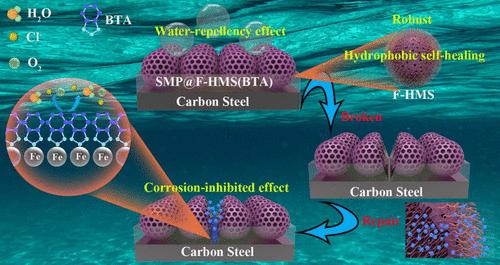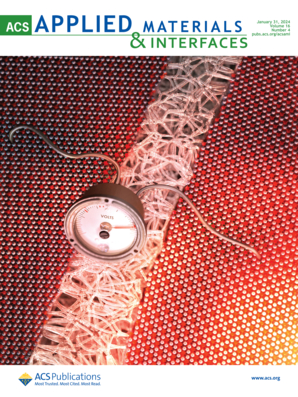具有多相排斥性能的自修复超疏水涂层
IF 8.3
2区 材料科学
Q1 MATERIALS SCIENCE, MULTIDISCIPLINARY
引用次数: 0
摘要
开发通用的、可扩展的、耐用的涂层,在不同的使用环境中排斥各种物质,对于工程材料的应用非常重要,但仍然具有很高的挑战性。本文将硬模板法制备的介孔二氧化硅微球(HMS)作为微纳容器,包封疏水剂全氟辛基三乙基氧基硅烷(F13)和缓蚀剂苯并三唑(BTA),形成功能微球F-HMS(BTA)。此外,将合成的有机硅烷改性硅溶胶粘合剂(SMP)和F-HMS(BTA)作为粘结剂和功能填料,通过可扩展喷涂在各种工程金属上构建SMP@F-HMS(BTA)超疏水自愈涂层。制备的涂层具有良好的机械耐久性和较强的抗大分子化合物、液体和冰晶等多相物质的吸积性,具有良好的防污和防冰性能。此外,由于功能添加剂在微纳容器中的自迁移释放,涂层具有疏水性和防腐自修复性能,表现出“主-被动”协同作用机制。在0.01 Hz频率下,电荷转移电阻Rct和恒相元件Ccpe分别为2.62 × 109 Ω cm2和9.63 × 10-10 F cm2。腐蚀电流密度降低了3-5个数量级,具有较好的耐蚀性。这项工作为制备功能保护涂层提供了一种可行的策略,可以广泛应用于解决粘附和腐蚀问题。本文章由计算机程序翻译,如有差异,请以英文原文为准。

Self-Healing Superhydrophobic Coatings with Multiphase Repellence Property
Developing versatile, scalable, and durable coatings that repel various matters in different service environments is of great importance for engineered materials applications but remains highly challenging. Here, the mesoporous silica microspheres (HMS) fabricated by the hard template method were utilized as micro-nanocontainers to encapsulate the hydrophobic agent of perfluorooctyltriethoxysilane (F13) and the corrosion inhibitor of benzotriazole (BTA), forming the functional microsphere of F-HMS(BTA). Moreover, the synthesized organosilane-modified silica sol adhesive (SMP) and F-HMS(BTA) were further employed as the binder and functional filler to construct a superhydrophobic self-healing coating of SMP@F-HMS(BTA) on various engineering metals through scalable spraying. The prepared coating exhibits good mechanical durability and strong resistance to accretion of multiphase substances including large molecule compounds, liquids, and ice crystals, demonstrating good antifouling and anti-icing properties. Moreover, the coatings possess hydrophobic and anticorrosion self-healing properties owing to the self-migration release of the functional additives in the micro-nanocontainers, showing the “active–passive” synergistic properties mechanism. At a frequency of 0.01 Hz, the charge transfer resistance Rct and the constant phase element Ccpe were measured to be 2.62 × 109 Ω cm2 and 9.63 × 10–10 F cm2, respectively. In addition, the corrosion current density was reduced by 3–5 orders of magnitude, indicating superior corrosion resistance. This work provides a feasible strategy to prepare functional protective coatings for a wide range of applications in addressing adhesion and corrosion issues.
求助全文
通过发布文献求助,成功后即可免费获取论文全文。
去求助
来源期刊

ACS Applied Materials & Interfaces
工程技术-材料科学:综合
CiteScore
16.00
自引率
6.30%
发文量
4978
审稿时长
1.8 months
期刊介绍:
ACS Applied Materials & Interfaces is a leading interdisciplinary journal that brings together chemists, engineers, physicists, and biologists to explore the development and utilization of newly-discovered materials and interfacial processes for specific applications. Our journal has experienced remarkable growth since its establishment in 2009, both in terms of the number of articles published and the impact of the research showcased. We are proud to foster a truly global community, with the majority of published articles originating from outside the United States, reflecting the rapid growth of applied research worldwide.
 求助内容:
求助内容: 应助结果提醒方式:
应助结果提醒方式:


